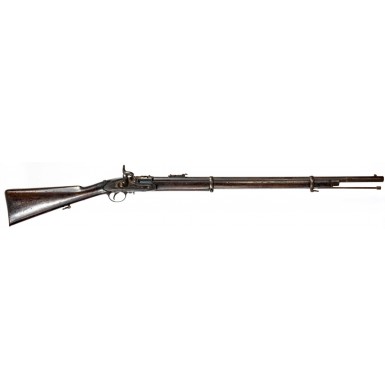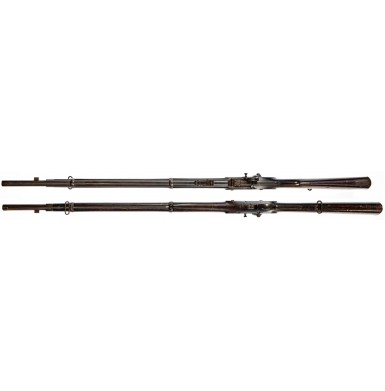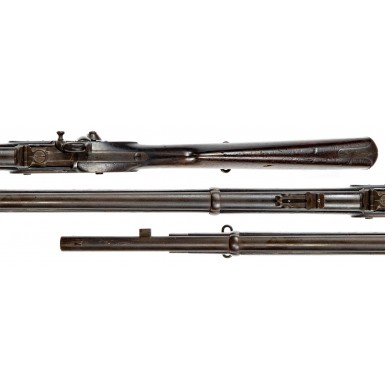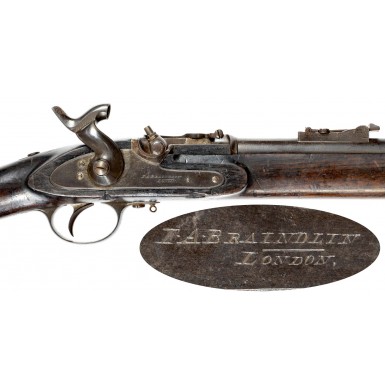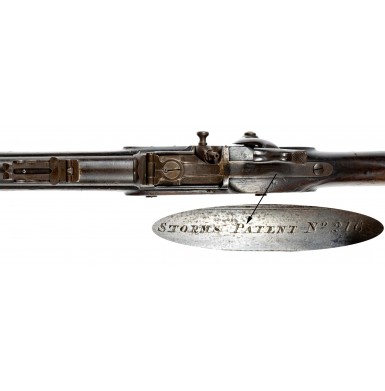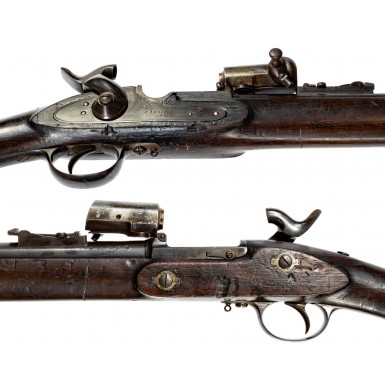Extremely Rare Japanese Boshin War Era Meiji Registered Mont Storm Enfield Rifle
- Product Code: FLA-3679-SOLD
- Availability: Out Of Stock
-
$1.00
Sometimes, in order to understand the significance of an historic weapon, one has to have at least a broad understanding of the historical context into which the weapon was thrust during its period of use. In order to understand the significance of the Japanese Meiji Era Registered Mont Storm Pattern 1861 Enfield Rifle offered here, nearly three hundred years of Japanese military and social history have to be at least summarized. Sometimes customers note that my descriptions are more akin to a history lesson than an antique arms description, but in this case, I do not think the significance and context of the rifle offered here can be appreciated without a substantial amount of background history. I would also like to note that I am indebted to a couple of important reference works in compiling the historical background on Feudal Japan, the era of the Boshin War, the Meiji Restoration and firearms within that historical context. First and foremost is Japanese Imported Arms of the Meiji Era by Francis C. Allan, Chip Goddard, Takehito Jimbo, Doss H. White and Dr, Stanley Zielinksi. The second, offering broader historical information for the period is A Brief History of the Samurai – The Way of Japan’s Elite Warrior Warriors by Jonathan Clements.
For well over two centuries, Japan had been an isolated country with minimal interaction with the outside world, other than some trade through the heavily regulated and restricted port of Nagasaki. The first westerns to arrive in Japan were the Portuguese, who reached the islands in 1543. This began Japanese interaction with western trade, inventions and religion. The Portuguese introduced a variety of previously unknown items and concepts to the Japanese, ranging from refined sugar, the concept of frying food in hot oil and western ship building techniques to hand-held firearms and Christianity. Over the next seventy years, a number of other western countries contacted Japan and established trade, although in the end, the Dutch would have the longest relationship with the island nation.
When the Portuguese first arrived in Japan, the five primary islands and thousands of smaller ones that comprise the Japanese archipelago, were not a unified country, but rather a collection of feudal lords and localized rulers. Some of these rulers had allegiance to other more powerful lords and rulers, and sometimes other farther reaching alliances and groups of allies would lend support to each other. The power was distributed quite regionally, typically based upon the family or clan’s power to enforce its will on the surrounding area. Six major ancient families or clans held the majority of power during this period, all holding influence over the emperor at some point in history and thus being his instrument of control during his reign. These ancient families held control over large regions of the home islands that were their traditional homelands.
During the period of our interest the Ashikaga clan and the Tokugawa clan were preeminent, although the ancient Fujiwara and Minamoto families still held great power as well. While there was no truly unified government, there was a titular head of the home islands, the Emperor of Japan. However, his power was no greater than the most powerful lords allowed it to be. The Emperor had no army, no method of enforcing his will and actually lived off the good graces of the various Daimyō (lords) who provided the royal court with their living expenses in the form of tribute, that were in essence voluntarily paid taxes. The emperor was the spiritual leader of Japan, as the people considered that he was descended from a god and a was in fact a living god himself. As early as the 7th century, the Japanese people had referred to their emperor as the “Son of Heaven”. The emperor’s power came from the various powerful families that supported him and in turn he often conferred the title of Shōgun upon the head of the family of his most powerful supporters. The Shōgun was a ruling military dictator, who was in charge of all “temporal” matters, allowing the “Son of Heaven” to concentrate on “spiritual” matters. An analogy common among the early Portuguese travelers to Japan was that the emperor was like the Pope of the period, highly regarded, wielding the great power of respect, but reliant upon his most powerful supporters to be the instrument to enforce his will; if they chose to do so.
During most of the Nanban Period (circa 1543-1614) there was much political and military maneuvering in Japan to establish a truly powerful, centralized government that would unify the islands completely. During the period it was much like the many smaller kingdoms in England that had not been unified under a single king. Eventually, as a leader became more powerful his range of control increased, but the further a particular lesser lord was from the center of power, the less likely that lord was to subjugate himself to the distant “ruler”. By the middle of the 16th century, power had been consolidated in much of Japan and the Ashikaga Shogunate was effectively ruling most of the country. A series of coup attempts to further centralize power resulted in the Shogun Ashika Yoshiaki attacking the lord that was the primary supporter for his power, Oda Nobunaga. The attempt failed and resulted in the end of the Ashikaga Shogunate. Nobunaga subsequently became the effective ruler of Japan, although he did not have total control or unification of the country. In 1582, he was murdered by one of his own retainers, who was in turn killed by Toyotomi Hideyoshi, one of Nobunaga’s chief subordinates. Hideyoshi then became the effective ruler of Japan. However, he could not be granted the Imperial rank of Shōgun, as he was not directly descended from one of the six ancient ruling families and was without a samurai lineage. It is interesting to note that Hideyoshi was the first ruler to ban the ownership of weapons by the peasant class, and in fact any class other than the Samurai, which he stratified as a professional warrior class. He also created the first Japanese ban on the ownership of firearms by any but the Samurai class.
Although the introduction of firearms by the Portuguese half a century earlier had been an interesting technological innovation, the very traditional Japanese military preferred the skill and discipline required to fight with swords and bows and arrows. There was also the general fear that firearms, in quantity, could tip the balance of power within the country. They required minimal training to be effective weapons in the hands of the general public. A master swordsman was produced after only a lifetime of study that often started very young. Firearms could potentially undermine the power of Samurai and the ruling class. For this reason, the musket was universally disdained by the military elite, although they did utilize firearms for specific purposes with specially trained musket regiments that often served as shock troops to soften an enemy prior to an attack or defensively to repel a larger attack.
The death of Hideyoshi in 1598 left the two major factions of power in Japan, the Tokugawa clan under the leadership of Tokugawa Ieyasu and the Toyotomi clan followers, who were led by Ishida Mitsunari. While Hideyoshi was alive, he had managed the delicate relationship between the two major power brokers. The various less powerful lords soon fell in line to support one or the other leader, resulting in some 75,000 soldiers to support the Tokugawa side (the Eastern Army) and roughly 120,000 for the Toyotomi side (the Western Army).
The decisive battle between the two sides was fought at Sekigahara on October 21, 1600. Despite being significantly outnumbered at the outset of the engagement, Tokugawa Ieyasu won a stunning victory. He had worked diligently in the weeks prior to the battle to establish alliances with some of the Toyotomi supporters, and on the day of the battle some of these leaders either remained neutral, not fighting for Ishida Mitsunari, or actually turning against the other Toyotomi followers during the battle. Tokugawa Ieyasu also used firearms quite effectively during the battle. He musket regiments as shock troops and also used nineteen bronze cannons that had been taken from a Dutch trading ship. Tokugawa Ieyasu’s men had been trained in the use of the artillery and in European musket tactics by the English navigator William Adams, who had been one of the few surviving members of the crew of the Dutch trading ship Liefde that had foundered in a typhoon off the island of Kyushu in April of 1600. The fictionalized version of this story is told in James Clavell’s Shōgun, with Adams being represented by the character Blackthorn. Although it would not be until 1603 that the Toyotomi clan essentially eradicated and Tokugawa Ieyasu would have complete control of Japan, the battle of Sekigahara is essentially considered the beginning of the Tokugawa Shogunate, or Edo Period of Japan. Tokugawa Ieyasu was made Shogun by the emperor in 1603 and the Tokugawa family would rule Japan in that capacity for more than 250 years.
The Tokugawa Shogunate soon enacted tight restrictions on foreign trade and western interaction. Missionaries were expelled, along with nearly all westerners. Western trade was limited to a small island in the port city of Nagasaki, where the Dutch alone were allowed access to the markets of Japan, handling all imports and exports.
One of the first edicts of the new Shogun not only further restricted the possession and use of firearms, it also restricted their manufacture to a single location within Japan. This gave the Tokugawa Shogunate complete control over all firearms production on the islands. It also meant that due to a lack of competition and innovation, combined with a ban on the importation of firearms, that in the mid-19th century the standard Japanese military firearm was still the antique matchlock mechanism arquebus (harquebus) of the Sekigahara era. In Japan these were known as Tanegashima-tsutsu. Tanegashima was the Japanese village into which the first firearms were introduced in 1543 and “tsutsu” means “barrels”.
When Commodore Perry entered the bay of Edo (now Tokyo) in 1853, he opened Japan to the rest of world. He also brought with him a wide variety of modern percussion firearms, including repeating firearms like the Colt Model 1839 Paterson Carbine. These were spectacular modern innovations to the Japanese.
Perry came at a turbulent time for the Japanese. More than two centuries of rule under the Tokugawa Shogunate and their bloated bureaucracy the Bakufu had left much of the country unhappy. The Bakufu ruled and administered the country ineffectively during the period, and the country was dealing with a financial crisis both, primarily due to a huge trade imbalance. Hereditary enemies of the Tokugawa family had allowed their hate and desire to return to power fester for some 250 years. The domains of Satsuma and Chōshū were particularly anti-Shogunate and were the homes of many of the displaced clans who were on the losing side after the battle of Sekigahara. These Toyotomi loyalists had lost their ancestral lands and power and had been relocated. In particular the formerly powerful Mori clan had lost their huge ancestral wealth and had ended up in Chōshū.
With the forced opening of Japan and the startling amount of westernization that occurred in the country over the coming decade, the Chōshū province became the center for a traditionalist, reactionary uprising against the Bakufu and the Tokugawa Shogunate. The movement was called sonnō jōi. This translated to “revere the Emperor, expel the barbarians” and certainly expressed the desires of the movement’s followers. They sought to return the emperor to full power as head of state and to eliminate the Tokugawa Shogunate and their Bakufu administration. Interestingly, the primary way in which these “traditionalists” sought to be able to overwhelm and Shogunate forces was to modernize their own armies and to acquire modern firearms from England, Europe and the United States. The end of the American Civil War in 1865 had made a huge number of obsolete percussion muzzleloading rifles and rifle muskets available on the secondary market from international arms traders like Schuyler, Hartley & Graham. While these guns were being replaced with modern metallic cartridge breechloaders in most of the world, a muzzleloading Enfield pattern rifle or rifle musket was a huge technological advantage against the traditional smoothbore Tanegashima-tsutsu matchlocks in Japan. Other firearms found their way into Japan through western traders as well, ranging from Spencer Carbines to Smith & Wesson Model No 2 revolvers, and everything in between. The traders were only too happy to arm what was looking to be a Japanese civil war.
During the 1860s a variety of small incidents and conflicts expanded the rift between the Imperial Court, Emperor Komei and the supporters sonnō jōi and the Tokugawa Shogunate. The Emperor ordered the expulsion of all barbarians in March of 1863, but the Shogunate refused to comply with the edict. As the Shogunate was the enforcement and administrative arm of the government, there was little the Emperor could do. The traditionalist supporters of the Emperor and sonnō jōi reacted to the Shogunate’s refusal to enforce the Imperial edict by launching a mostly guerrilla style campaign against the Shogunate, its supporters and most importantly foreigners in Japan. This culminated with the Hamaguri Rebellion in 1864, which was quickly put down by the Shogunate.
As tensions grew, the various western nations started to jockey for position in what they saw as the very lucrative Japanese trade, particularly in the modernization of both the country and its military. To that end, they started to take sides to help and support either the pro-Shogunate or pro-Imperial forces. In particular the French supported the Tokugawa Shogunate and the English supported the pro-Imperial forces, including the anti-Shogunate rebels of the Satsuma and Chōshū provinces.
In 1868, an all-out war erupted and the Boshin War, or Japanese Civil War began. The more modern pro-Imperial, anti-Shogunate forces won, in particular due to the large number of modern, western firearms that were made available to them. By the summer of 1869, the Shogunate was essentially defeated and ruling power was in the process of being returned to the Emperor. The few anti-Imperial, Shogunate loyalists that remained retreated to the northern part of Japan, but they were hounded by the pro-Imperial forces and eventually defeated. On October 26, 1869 the old Tokugawa capital city of Edo was renamed Tokyo and the Meiji period began, with the Emperor Meiji being restored to power, thus the often used term Meiji Restoration. At this time the traditional Imperial Court home of Kyoto was transferred to Tokyo.
A sweeping restructuring of the Japanese ruling class followed almost immediately during the early days of the Meiji Restoration. Very quickly the old feudal lords (daimyō) were eliminated, old fiefs were restructured, and the old system of local government converted from a powerful lord ruling over vassals that worked his land to an Imperial appointed governor ruling over a prefecture with essentially free inhabitants. Some 302 old feudal domains were restructured as prefectures, and in the coming years the number of these prefectures was further reduced to more manageable number and to more easily centralize the ruling authority of the Emperor and his administration. Additionally, the Samurai class was abolished, ending more than 250 years of control by a group of hereditary warriors who could for all practical purposes take the life of a peasant at any time for nearly any reason. Many of the disenfranchised Samurai found work as administrators within the new governments, as Samurai were typically well educated and could read and write. Others, however, were ruined financially, particularly the lower level Samurai who had lived as the retainers of a wealthy lord who took care of their welfare. For the first time ever, the people of every Japanese class were given the freedom to pursue any career or occupation they chose to and were expected to participate in the overall administration of the nation.
Interestingly one of the primary goals of the sonnō jōi movement had been to “expel the barbarians”, but the new Imperial administration sought to modernize the country of Japan and developed numerous international relationships that certainly chafed at the supporters who had returned the Emperor to power. Possibly in response to what the new Imperial administration expected to be a backlash, on July 8, 1869 the Imperial government established the Bukoshi, or Arsenal Administration. This organization was charged with the collection, registration and “control” of all firearms in Japan. These included, but were not limited to handguns, rifles and even cannon. The new administration understood that these imported weapons, that had been cached around the country under the control of various daimyōs had been instrumental in the success of the pro-Imperial forces during the Boshin War, but could be equally effective at over throwing the new Imperial government; if such an uprising could occur before the government had fully centralized power and built up a strong Imperial Army. By 1872, it was decreed that all breechloading firearms be transferred to Imperial government control in Tokyo and soon thereafter all Enfield pattern rifles be forwarded to Imperial arsenals for alteration to breechloader by the Albini system.
The registration, collection and control of firearms during the early days of the Meiji Era was providential for the regime. In 1874, the prefecture of Saga on the island of Kyushu rebelled against the new Meiji government. This was a small and poorly organized rebellion that was quickly suppressed by Imperial forces. However, it set the stage for the much larger Satsuma Rebellion three years later. In 1877, the Satsuma province on the island of Kyushu rebelled. Ironically this was one of the major regions to support the uprising against the Tokugawa Shogunate less than 10 years earlier. However, the change in attitude by the Imperial administration towards western influence, the elimination of the noble class and their land holdings, the elimination of the Samurai and the forbidding of the wearing of the two swords in public in 1876 was simply too much. The traditionalists rebelled and were crushed by Imperial Forces. While the account of this uprising as told in the movie The Last Samurai is certainly a highly fictionalized portrayal of the events, the final outcome was the same. The Imperial forces, armed with relatively modern weapons easily defeated the last of the rebellious Samurai, who were largely armed with the traditional sword and bow.
All of the preceding is necessary to understand the historical importance of the rifle offered for sale here. It is a Mont Storm Breechloading English Pattern 1861 Enfield Rifle with Meiji Era registration markings. The Kanji stamped on the butt read “Jinshin San-Byaku-Niju-Ni-Ban” and “Imari-Ken”. This translates to Registration Number 322 Imari-Prefecture. We can narrow the period of registration to between the fall of 1871 and the spring of 1872, because the Imari Prefecture was a very short-lived Meiji Era prefecture. On November 14, 1871 the former hans (fiefs of the daimyōs) of Saga, Sashike, Ogi, Kashima, Karatsu and part of Tsushima on the island of Kyushu were consolidated to form the Imari Prefecture. On May 29, 1872, this prefecture was renamed the Saga Prefecture and retains that name to this day. This registration indicates that the rifle was in the Imari Prefecture in late 1871 (Meiji 4) to early 1872 (Meiji 5), on the island of Kyushu. This had been one of the primary locations for pro-Imperial forces prior to the Meiji Restoration. The local daimyōs had arranged to the smuggling of thousands of small arms into the region to support the anti-shogunate uprising and had been particularly helped and supported in this matter by the English. In fact, the Scottish trader Thomas Blake Glover provided many of the English arms to the buyers in this region. It is also worth noting that there is the possibility that this rifle, in addition to almost certainly being used by pro-Imperial forces during the Meiji Restoration of 1868-1869, may well have seen use again during the Saga Uprising of 1874 by the anti-Imperial rebels in that province. If the gun was actually forwarded to Tokyo as breechloaders were ordered to be in late 1872, it is possible that the rifle saw use by pro-Imperial forces again while putting down the Satsuma Rebellion of 1877. The historical significance of where and when the rifle was registered during the Meiji Era is completely lost without the background and context of the importance of that region of Kyushu before the restoration of Emperor Meiji and in the decade immediately following his return to power.
As noted, the rifle is a Mont Storm Pattern 1861 Enfield Short Rifle. The Mont Storm system was a capping breechloading system was invented by an American; William Montgomery Storm. Storm was born on August 2, 1826 in New York and would become a famous American inventor who would register some 33 patents during his lifetime. His first US patent for an “Improved Method of Obtaining Motive Power” was granted on February 4, 1851. He would subsequently receive at least 5 US patents for firearms, including #15,307 on July 8, 1856 and #24,414 on June 14, 1859; both
Tags: Extremely, Rare, Japanese, Boshin, War, Era, Meiji, Registered, Mont, Storm, Enfield, Rifle


